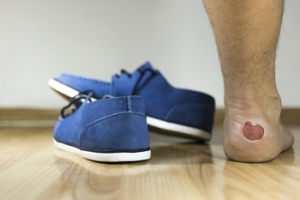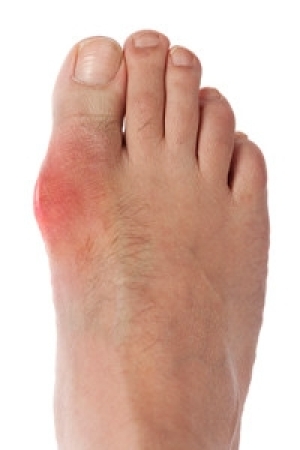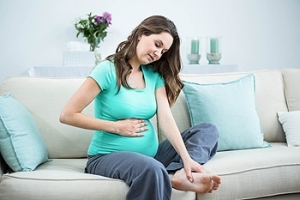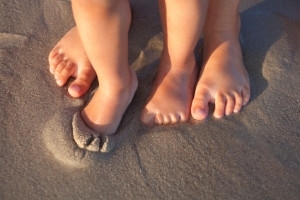Super User
Possible Causes of Blisters
 If you have ever experienced a blister, you are most likely familiar with the pain and discomfort that is generally caused from this condition. It can develop from wearing shoes that do not fit correctly. Friction happens as a result of a portion of the foot rubbing against a part of the shoe. This may damage the top layer of skin, and a blister will form as the body’s natural defense mechanism against a skin injury. It looks like small bubble, and is filled with a fluid that protects the raw skin. Once the skin has healed, the blister will naturally drain as new skin grows. Additional reasons why blisters occur can include severe burns, frostbite, or an allergic reaction to an insect bite. If you have a blister that is not healing, it is suggested to speak with a podiatrist who can advise you on proper care.
If you have ever experienced a blister, you are most likely familiar with the pain and discomfort that is generally caused from this condition. It can develop from wearing shoes that do not fit correctly. Friction happens as a result of a portion of the foot rubbing against a part of the shoe. This may damage the top layer of skin, and a blister will form as the body’s natural defense mechanism against a skin injury. It looks like small bubble, and is filled with a fluid that protects the raw skin. Once the skin has healed, the blister will naturally drain as new skin grows. Additional reasons why blisters occur can include severe burns, frostbite, or an allergic reaction to an insect bite. If you have a blister that is not healing, it is suggested to speak with a podiatrist who can advise you on proper care.
Blisters may appear as a single bubble or in a cluster. They can cause a lot of pain and may be filled with pus, blood, or watery serum. If your feet are hurting, contact one of our podiatrists of Carolina Foot & Ankle. Our doctors can provide the care you need to keep you pain-free and on your feet.
Foot Blisters
Foot blisters are often the result of friction. This happens due to the constant rubbing from shoes, which can lead to pain.
What Are Foot Blisters?
A foot blister is a small fluid-filled pocket that forms on the upper-most layer of the skin. Blisters are filled with clear fluid and can lead to blood drainage or pus if the area becomes infected.
Symptoms
(Blister symptoms may vary depending on what is causing them)
- Bubble of skin filled with fluid
- Redness
- Moderate to severe pain
- Itching
Prevention & Treatment
In order to prevent blisters, you should be sure to wear comfortable shoes with socks that cushion your feet and absorb sweat. Breaking a blister open may increase your chances of developing an infection. However, if your blister breaks, you should wash the area with soap and water immediately and then apply a bandage to the affected area. If your blisters cause severe pain it is important that you call your podiatrist right away.
If you have any questions, please feel free to contact one of our offices located in Huntersville Office | 16419 Northcross Dr Suite A, Huntersville, NC 28078; Mooresvillle Office | 206 Joe Knox Avenue Suite D, Mooresville, NC 28117; and Mountain Island | 10310 Couloak Drive Suite 200, Charlotte, NC 28216 . We offer the newest diagnostic and treatment technologies for all your foot care needs.
Blisters
Blisters are small pockets of fluid that occur on the top layers of the skin for several reasons. Friction, burns, and diseases are all known causes of blisters. Smaller blisters are known as vesicles, while larger blisters are referred to as bulla. The fluid inside the bubble can be blood, pus, or serum; which is a clear liquid that protects the skin. In most cases, blisters are not a major health issue, but they can be an indicator of a more serious condition.
Causes of blisters vary. Blisters are commonly caused by wearing poorly fitted shoes that rub against the foot. However, there are many other causes besides from friction; including burns, sunburn, insect bites, frostbite, poison ivy/oak, chemical exposure, impetigo, eczema, viral infections, and more.
Most blisters heal by themselves and do not require immediate medical care. If you have a blister, do not pop it since this may cause infection; it is advised to put a bandage over the blister to protect it. If the blister is large, causes pain, or if you have a fever, it is recommended that you see a doctor who can provide proper care. Blisters are easy to diagnose, and if considered prudent by the doctor, can easily be drained of fluid with a sterile needle as well.
To prevent blisters on the feet, wear shoes that fit properly and don’t cause rubbing. Socks can help prevent friction and it is recommended that you wear them if you are wearing shoes. Hand blisters can be avoided by wearing gloves during activities that cause friction against the hand. If you have a blister that pops, do not remove the dead skin, wash the area, apply antibiotic ointment, and cover with a bandage. It is okay in most cases to not seek immediate medical care for a blister if it was just caused by friction. However, if the blister causes pain or does not go away, it is suggested that you see a doctor for a diagnosis.
What Is Gout Caused By?
 If the joint surrounding your big toe becomes inflamed and irritated, you may have a condition that is known as gout. Gout is considered to be a form of arthritis and typically causes severe pain and discomfort. Many patients experience gout attacks, which can occur suddenly and can last for extended periods of time. Some of the symptoms that are associated with gout may include heat emanating from the affected toe, redness, and swelling. Gout is generally caused by a condition that is known as hyperuricemia. This is the medical term given when there is excess uric acid in the blood levels. Uric acid comes from purines, which can be found in certain foods. If there is too much uric acid in the body, crystals may form in the joints of the big toe. This causes gout to develop. Gout can be managed when certain lifestyle changes are made, including making healthy eating choices and following a light exercise program. If you have gout, it may be considered to speak to a podiatrist.
If the joint surrounding your big toe becomes inflamed and irritated, you may have a condition that is known as gout. Gout is considered to be a form of arthritis and typically causes severe pain and discomfort. Many patients experience gout attacks, which can occur suddenly and can last for extended periods of time. Some of the symptoms that are associated with gout may include heat emanating from the affected toe, redness, and swelling. Gout is generally caused by a condition that is known as hyperuricemia. This is the medical term given when there is excess uric acid in the blood levels. Uric acid comes from purines, which can be found in certain foods. If there is too much uric acid in the body, crystals may form in the joints of the big toe. This causes gout to develop. Gout can be managed when certain lifestyle changes are made, including making healthy eating choices and following a light exercise program. If you have gout, it may be considered to speak to a podiatrist.
Gout is a foot condition that requires certain treatment and care. If you are seeking treatment, contact one of our podiatrists from Carolina Foot & Ankle. Our doctors will treat your foot and ankle needs.
What Is Gout?
Gout is a type of arthritis caused by a buildup of uric acid in the bloodstream. It often develops in the foot, especially the big toe area, although it can manifest in other parts of the body as well. Gout can make walking and standing very painful and is especially common in diabetics and the obese.
People typically get gout because of a poor diet. Genetic predisposition is also a factor. The children of parents who have had gout frequently have a chance of developing it themselves.
Gout can easily be identified by redness and inflammation of the big toe and the surrounding areas of the foot. Other symptoms include extreme fatigue, joint pain, and running high fevers. Sometimes corticosteroid drugs can be prescribed to treat gout, but the best way to combat this disease is to get more exercise and eat a better diet.
If you have any questions please feel free to contact one of our offices located in Huntersville Office | 16419 Northcross Dr Suite A, Huntersville, NC 28078; Mooresvillle Office | 206 Joe Knox Avenue Suite D, Mooresville, NC 28117; and Mountain Island | 10310 Couloak Drive Suite 200, Charlotte, NC 28216 . We offer the newest diagnostic and treatment technologies for all your foot and ankle needs.
Everything You Need to Know About Gout
Gout, typically found in diabetic patients, is an unusually painful form of arthritis caused by elevated levels of uric acid in the bloodstream. The condition typically strikes the big joint on the big toe. It has also been known to strike the knees, elbows, fingers, ankles and wrists—generally anywhere that has a functioning, moving joint.
The high level of uric acid in a person’s bloodstream creates the condition known as hyperuricema—the main cause of gout. Genetic predisposition occurs in nine out of ten sufferers. The children of parents who suffer gout will have a two in ten chance of developing the condition as well.
This form of arthritis, being particularly painful, is the leftover uric acid crystallizing in the blood stream. The crystallized uric acid then travels to the space between joints where they rub, causing friction when the patient moves. Symptoms include: pain, redness, swelling, and inflammation. Additional side effects may include fatigue and fever, although reports of these effects are very rare. Some patients have reported that pain may intensify when the temperature drops, such as when you sleep.
Most cases of gout are easily diagnosed by a podiatrist’s assessment of the various symptoms. Defined tests can also be performed. A blood test to detect elevated levels of uric acid is often used as well as an x-ray to diagnose visible and chronic gout.
Treatment for gout simply means eliminating symptoms. Non-steroid anti-inflammatory drugs or NSAIDs (Colchicine and other corticosteroid drugs, etc.) will quell the redness, the swelling, and the inflammation. However, managing your diet, lifestyle changes, and using preventative drugs are all helpful toward fully combating the most severe cases.
Those that lead an inactive lifestyle are at a higher risk for gout. Any amount of exercise decreases the probability of repeat encounters with the condition. Reducing your consumption of red meat, sea food, and fructose-sweetened drinks also reduces the likelihood of chronic gout as well.
Ingesting Vitamin C, coffee, and particular dairy products can help with maintaining a healthy lifestyle. There are new drugs out on the market that inhibit the body’s production of uric acid-producing enzymes. However, reducing or eliminating your overall levels of uric acid is the best remedy to ensuring you lead a gout-free life.
Swollen Feet and Pregnancy
 As pregnancy progresses, the body’s natural response is to produce additional fluids that accommodates the needs of the growing fetus. Most women experience swollen feet as a result of this, which can be uncomfortable. Research has indicated this accounts for approximately twenty-five percent of the weight that is gained during pregnancy. There are additional reasons why the feet become swollen. These include standing for extended periods of time, drinking large amounts of caffeine, or eating foods that are high in sodium content. There are methods that can be implemented to help reduce possible swelling. These consist of elevating your feet frequently throughout the day, wearing shoes that are comfortable, and spending limited time outside in the warmer weather. If you would like additional information about how pregnancy affects the feet, it is suggested to speak to a podiatrist who can answer any questions you may have.
As pregnancy progresses, the body’s natural response is to produce additional fluids that accommodates the needs of the growing fetus. Most women experience swollen feet as a result of this, which can be uncomfortable. Research has indicated this accounts for approximately twenty-five percent of the weight that is gained during pregnancy. There are additional reasons why the feet become swollen. These include standing for extended periods of time, drinking large amounts of caffeine, or eating foods that are high in sodium content. There are methods that can be implemented to help reduce possible swelling. These consist of elevating your feet frequently throughout the day, wearing shoes that are comfortable, and spending limited time outside in the warmer weather. If you would like additional information about how pregnancy affects the feet, it is suggested to speak to a podiatrist who can answer any questions you may have.
Pregnant women with swollen feet can be treated with a variety of different methods that are readily available. For more information about other cures for swollen feet during pregnancy, consult with one of our podiatrists from Carolina Foot & Ankle. Our doctors will attend to all of your foot and ankle needs.
What Foot Problems Can Arise During Pregnancy?
One problem that can occur is overpronation, which occurs when the arch of the foot flattens and tends to roll inward. This can cause pain and discomfort in your heels while you’re walking or even just standing up, trying to support your baby.
Another problem is edema, or swelling in the extremities. This often affects the feet during pregnancy but tends to occur in the later stages.
How Can I Keep My Feet Healthy During Pregnancy?
- Wearing orthotics can provide extra support for the feet and help distribute weight evenly
- Minimize the amount of time spent walking barefoot
- Wear shoes with good arch support
- Wear shoes that allow for good circulation to the feet
- Elevate feet if you experience swelling
- Massage your feet
- Get regular, light exercise, such as walking, to promote blood circulation to the feet
If you have any questions please feel free to contact one of our offices located in Huntersville Office | 16419 Northcross Dr Suite A, Huntersville, NC 28078; Mooresvillle Office | 206 Joe Knox Avenue Suite D, Mooresville, NC 28117; and Mountain Island | 10310 Couloak Drive Suite 200, Charlotte, NC 28216 . We offer the newest diagnostic and treatment technologies for all your foot and ankle needs.
Foot Care for Pregnant Women
The natural weight that pregnant women gain causes their center of gravity to be completely altered. This causes them to have a new weight-bearing stance which adds pressure to the knees and feet. As a result, pregnant women often experience severe foot pain. The two most common foot issues experienced by women in their pregnancies are edema and over-pronation. It is important for all pregnant women to learn more about how to take care of their feet so they are more comfortable during their pregnancy.
Over-pronation, which is commonly referred to as flat feet, is caused when a person’s arch flattens out upon weight bearing. This causes the person’s feet to roll inward while walking. Pregnant women often experience this due to the sudden weight they gain.
Edema, also referred as swelling in the feet, typically occurs in the later part of the pregnancy. It is the result of the extra blood accumulated in the pregnant woman’s body. The enlarged uterus puts more pressure on the blood vessels in the pelvis which causes leg circulation to slow down. This causes blood to pool in the lower extremities.
Fortunately, there are ways to treat both edema and over-pronation. Edema can be treated by elevating the foot as often as possible. Wearing proper fitting footwear will also be helpful for those with edema. A treatment method for over-pronation could be orthotics. Orthotic inserts should be designed with appropriate arch support and medial rear foot for your foot.
It is best for pregnant women to buy new shoes during the day, because this is the time where swelling is at its peak. Pregnant women also shouldn’t rush when buying shoes. It is always advised that you make sure your shoes fit properly but this is especially important during pregnancy.
If you are a pregnant woman, you should consult with a podiatrist in order to make sure your feet are healthy throughout the entirety of your pregnancy.
The Complexity of the Human Foot
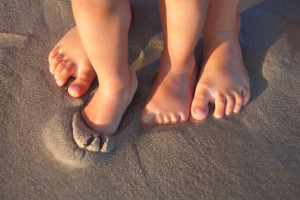 The human foot is comprised of several bones, ligaments, and muscles. It is important that our feet are flexible and stable so everyday activities can be completed with ease. Children may benefit at an early age from walking barefoot while indoors. This may help develop the grasping action in the toes, which can promote stability and muscle strength. Research has indicated the importance of measuring your child’s feet on a regular basis, and this is helpful in determining the correct shoe size. When choosing shoes for your child, it is important to ensure the foot is held firmly in place. This may be accomplished by choosing shoes that have laces or Velcro, which can hold the foot securely in the shoe. If you would like additional information on how to care for your child's feet, speak with your podiatrist.
The human foot is comprised of several bones, ligaments, and muscles. It is important that our feet are flexible and stable so everyday activities can be completed with ease. Children may benefit at an early age from walking barefoot while indoors. This may help develop the grasping action in the toes, which can promote stability and muscle strength. Research has indicated the importance of measuring your child’s feet on a regular basis, and this is helpful in determining the correct shoe size. When choosing shoes for your child, it is important to ensure the foot is held firmly in place. This may be accomplished by choosing shoes that have laces or Velcro, which can hold the foot securely in the shoe. If you would like additional information on how to care for your child's feet, speak with your podiatrist.
Making sure that your children maintain good foot health is very important as they grow. If you have any questions, contact one of our podiatrists of Carolina Foot & Ankle. Our doctors can provide the care you need to keep you pain-free and on your feet.
Keeping Children's Feet Healthy
Having healthy feet during childhood can help prevent medical problems later in life, namely in the back and legs. As children grow, their feet require different types of care. Here are some things to consider...
Although babies do not walk yet, it is still very important to take care of their feet.
Avoid putting tight shoes or socks on his or her feet.
Allow the baby to stretch and kick his or her feet to feel comfortable.
As a toddler, kids are now on the move and begin to develop differently. At this age, toddlers are getting a feel for walking, so don’t be alarmed if your toddler is unsteady or ‘walks funny’.
As your child gets older, it is important to teach them how to take care of their feet.
Show them proper hygiene to prevent infections such as fungus.
Be watchful for any pain or injury.
Have all injuries checked by a doctor as soon as possible.
Comfortable, protective shoes should always be worn, especially at play.
If you have any questions please feel free to contact one of our offices located in Huntersville Office | 16419 Northcross Dr Suite A, Huntersville, NC 28078; Mooresvillle Office | 206 Joe Knox Avenue Suite D, Mooresville, NC 28117; and Mountain Island | 10310 Couloak Drive Suite 200, Charlotte, NC 28216 . We offer the newest diagnostic and treatment technologies for all your foot and ankle needs.
What to Do to Keep Your Child’s Feet Healthy
Being a parent involves caring for your child in every way you can. You make sure they are eating the right food, being nice to others, and staying out of any trouble. However, it is also important that you are watchful of their health, more specifically their foot health. Maintaining good foot health in childhood is important in preventing later conditions in life from happening. As children continue to develop, their feet require different techniques of care. Here are some various ways in which you can help your child’s feet stay healthy.
A baby needs a lot of care and attention overall, but the importance of their feet should never be forgotten. Before a baby turns one, their feet change and develop greatly. It is important that during this time, a mother avoids putting tight socks on their child. She should also encourage movement of their feet so the baby can begin to feel more comfortable using them.
As a baby enters the toddler years of his or her life, they are begin to walk around. When your baby begins to take those first steps, it is crucial that they are wearing protective shoes on their feet. As a mother that is observant of your child’s feet, you may notice changes in them. This is completely normal as the feet are becoming susceptible to the activity of walking. It is normal for a toddler to be a bit unsteady or to “walk funny” at first.
When your child grows out of their toddler years, it is important that you begin to show him or her how to care for their feet on their own. Practice with your child proper hygiene in order to prevent foot fungus or infection. Since children are constantly on the move, it is crucial to be cautious of any accidents or injuries that might occur. If an injury occurs, it is advised that you take your child to be examined by a doctor immediately. Since your child is still growing, particular injuries can shift the way in which a bone or other important part of the foot is developing.
Babies and kids are always changing and growing. Your job as a parent is to make sure they stay healthy and making sure they are properly maintained. This involves proper foot care and making sure the feet stay healthy. Following this guide, your child can live a long and happy life.
What Is Tarsal Tunnel Syndrome?
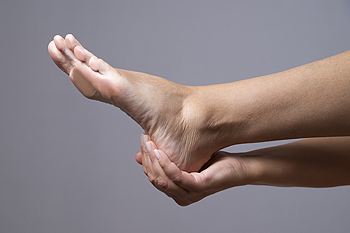 Tarsal tunnel syndrome is a condition that affects the posterior tibial nerve. This nerve runs along the inside of the ankle and foot, and when it becomes compressed and damaged it will become inflamed. This damage can be caused by continuous overuse of the foot and ankle. This might happen while participating in strenuous physical activities. Tarsal tunnel syndrome can also occur after a traumatic injury, and sometimes it develops suddenly without any obvious cause. Luckily, this is considered a rare condition. If it goes untreated, however, it can cause permanent nerve damage. If tarsal tunnel syndrome is caught early, then it is relatively easy to treat. If the condition becomes severe, then more aggressive treatments may need to be performed. Examples of treatment for severe cases include corrective devices, therapies, and sometimes surgery. If you believe you might have tarsal tunnel syndrome, then it is strongly recommended you consult with a podiatrist.
Tarsal tunnel syndrome is a condition that affects the posterior tibial nerve. This nerve runs along the inside of the ankle and foot, and when it becomes compressed and damaged it will become inflamed. This damage can be caused by continuous overuse of the foot and ankle. This might happen while participating in strenuous physical activities. Tarsal tunnel syndrome can also occur after a traumatic injury, and sometimes it develops suddenly without any obvious cause. Luckily, this is considered a rare condition. If it goes untreated, however, it can cause permanent nerve damage. If tarsal tunnel syndrome is caught early, then it is relatively easy to treat. If the condition becomes severe, then more aggressive treatments may need to be performed. Examples of treatment for severe cases include corrective devices, therapies, and sometimes surgery. If you believe you might have tarsal tunnel syndrome, then it is strongly recommended you consult with a podiatrist.
Tarsal tunnel syndrome can be very uncomfortable to live with. If you are experiencing tarsal tunnel syndrome, contact one of our podiatrists of Carolina Foot & Ankle. Our doctors can provide the care you need to keep you pain-free and on your feet.
Tarsal Tunnel Syndrome
Tarsal tunnel syndrome, which can also be called tibial nerve dysfunction, is an uncommon condition of misfiring peripheral nerves in the foot. The tibial nerve is the peripheral nerve in the leg responsible for sensation and movement of the foot and calf muscles. In tarsal tunnel syndrome, the tibial nerve is damaged, causing problems with movement and feeling in the foot of the affected leg.
Common Cause of Tarsal Tunnel Syndrome
- Involves pressure or an injury, direct pressure on the tibial nerve for an extended period of time, sometimes caused by other body structures close by or near the knee.
- Diseases that damage nerves, including diabetes, may cause tarsal tunnel syndrome.
- At times, tarsal tunnel syndrome can appear without an obvious cause in some cases.
The Effects of Tarsal Tunnel Syndrome
- Different sensations, an afflicted person may experience pain, tingling, burning or other unusual sensations in the foot of the affected leg.
- The foot muscles, toes and ankle become weaker, and curling your toes or flexing your foot can become difficult.
- If condition worsens, infections and ulcers may develop on the foot that is experiencing the syndrome.
A physical exam of the leg can help identify the presence of tarsal tunnel syndrome. Medical tests, such as a nerve biopsy, are also used to diagnose the condition. Patients may receive physical therapy and prescriptive medication. In extreme cases, some may require surgery.
If you have any questions please feel free to contact one of our offices located in Huntersville Office | 16419 Northcross Dr Suite A, Huntersville, NC 28078; Mooresvillle Office | 206 Joe Knox Avenue Suite D, Mooresville, NC 28117; and Mountain Island | 10310 Couloak Drive Suite 200, Charlotte, NC 28216 . We offer the newest diagnostic and treatment technologies for all your foot and ankle needs.
Tarsal Tunnel Syndrome
Tarsal tunnel syndrome is a condition in which there is a compression of the posterior tibial nerve. The posterior tibial nerve runs along the inside of the ankle into the foot. Tarsal tunnel syndrome is named for the tarsal tunnel, which is a thin space along the inside of the ankle beside the ankle bones. This space contains various nerves, arteries, and tendons, and includes the posterior tibial nerve. The tibial nerve is the peripheral nerve in the leg responsible for sensation and movement of the foot and calf muscles. In tarsal tunnel syndrome the tibial nerve is compressed, causing tingling or burning, numbness, and pain.
Common causes of tarsal tunnel syndrome involve pressure or an injury. Injuries that produce inflammation and swelling in or around the tunnel may place pressure on the posterior tibial nerve. Direct pressure on the tibial nerve for an extended period of time, sometimes caused by other body structures close by or trauma to the tibial nerve, can result in tarsal tunnel syndrome. Diseases that damage nerves, such as diabetes or arthritis, may cause tarsal tunnel syndrome. Those with flat feet are at risk for developing the condition, as the extra pressure and strain placed on the foot may compress the posterior tibial nerve.
Feeling different sensations in the foot at different times is a common symptom of tarsal tunnel syndrome. An afflicted person may experience pain, tingling, burning or other unusual sensations in the foot of the affected leg. Symptoms are primarily felt on bottom of the foot and/or the inside of the ankle. Symptoms can appear suddenly and may occur due to overuse of the foot.
To diagnose tarsal tunnel syndrome, your podiatrist may examine the foot and tap the posterior tibial nerve to see if symptoms surface. He or she may also order an MRI to determine if a mass is present.
Treating tarsal tunnel syndrome will depend on the decision of your podiatrist. Multiple options are available, however, and can include rest, ice, immobilization, oral medications such as anti-inflammatory drugs (NSAIDS), physical therapy, injection therapy, orthotics, supportive shoes, braces, and surgery.
